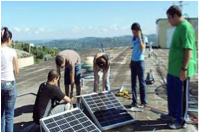GRADUATE RESEARCH
PAST STUDENTS:
Carlos Wah
 Thesis Title: TROPICAL RAINFALL RATE RELATION ASSESSMENTS FROM DUAL POLARIZED X BAND WEATHER RADARS
Thesis Title: TROPICAL RAINFALL RATE RELATION ASSESSMENTS FROM DUAL POLARIZED X BAND WEATHER RADARS
Three rainfall algorithms were examined and analyzed, for the purpose of helping in the prevention of major disasters. Rainfall rate estimation is one of the priorities in radar meteorology in part due to the uncertainties introduced by climate change. The accurate estimation and prediction of rainfall rate is important to provide early warnings, which can save properties, and most importantly, lives. This thesis consists in the developing of a code, which calculates the relation of rainfall rate from a network of the Dual Polarized X-band radars, localized at the west coast of Puerto Rico. These programs will be validated with a ground-based disdrometers network, installed at UPRM and UPRAg. To make the validation of the data collected by the three Dual Polarized X-band radars, a minimum of 10 events of moderate to heavy rain had been identified, where two of them are the near pass of the Tropical Storm Bertha and Tropical Depression Cristobal.
Topics: polarimetric radars, rainfall estimation, disdrometers
Graduation Date: May 2016
Funding: UPRM
Currently: PhD Student at UPRM ECE Department
Andres Saavedra Ruiz

Thesis Title: DIGITAL SIGNAL ANALYSIS FOR DETECTION OF AIR BUBBLES ON ARTIFICIAL THIGH VESSELS
Decompression sickness is present when the body is exposed to sudden changes in pressure. In divers, the risk increases as the depth of 30-40 meters is overcome, so that this risk is prevented, a table has been developed indicating divers ascent rates, decline rates, waiting time for decompression stops. The continuous apparition of decompression sickness is a problem that continues to be studied since it occurs in divers that followed the dive table instructions. Research has been conducted to determine the effects of decompression sickness; alternative systems to detect decompression sickness are used, but these systems are not applicable in real time.
Methods such as Doppler bubble detection has been discussed, however, the response of output signals to detect bubbles seems to be too sensitive and not reliable. Other ultrasound methods have been investigated; dual frequency and harmonic ultrasound are some of them. These methods failed to provide concrete responses to the presence of bubbles, the tissues must be harmonics and response signals are not strong to the passage of a bubble, the constraints are the two methods showed previous, respectively.
A new method that uses electrical signals form piezoelectric ring (PZT) to indicate the presence of bubbles, the amount of bubbles and the bubble size could be realized, if the correlation between the electrical signals and the presence of bubbles exist, a pattern recognition can be developed to indicate the user to ascend, descend or stop. To avoid the risks involved with the diving activity (activity that is not only entertaining, it is also a profession), this should carry device capable of transmitting signals in real time, is the main objective of this research.
Topics: decompression sickness, using electrical signals to detect bubbles presence and size, pattern recognition
Graduation Date: December 2014
Funding: (DoD)
Currently:
Keyla Maria Mora Navarro

Thesis Title: DEVELOPMENT AND IMPLEMETATION OF AN ATTENUATION CORRECTION ALGORITHM FOR CASA OFF THE GRID X-BAND RADAR NETWORK
The Collaborative Adaptive Sensing of the Atmosphere (CASA) Engineering Research Center (ERC) at UPRM developed an Off-The-Grid (OTG) X-band single polarized radar network deployed in the Puerto Rico west coast. With this kind of radar it is possible to observe some meteorological events that might not be detected by NEXRAD radar due to earth curvature. For this reason the main goal of this research is to break with the paradigm and limitations of using X-band OTG radars as a reliable forecast system, where the principal issue is the attenuation due to rain along the path. To overcome this problem the attenuated signal could be rectified through a correction algorithm based on reflectivity and also an ideal polarization (vertical or horizontal) will be identified to certain effects of rain attenuation. To correct for attenuation a hybrid between Hitschfeld–Bordan (HB) method and a Surface Reference Technique (SRT) would be used where the reference signal is the NEXRAD radar data because is considered negligible to attenuation.
Topics: attenuation correction, effect of polarization on attenuation
Graduation Date: December 2012
Funding: CASA
Currently: PhD Student at University of São Paulo



